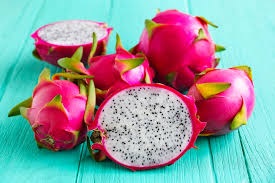
dragon fruit benefits
Dragon fruit, also known as pitaya, is a vibrant and nutrient-rich tropical fruit with an eye-catching appearance and a wealth of health benefits. Native to Central America and now cultivated across tropical and subtropical regions worldwide, this exotic fruit has gained popularity not only for its unique look but also for its impressive nutritional profile. In this article, we’ll explore the incredible benefits of dragon fruit, its nutritional value, potential side effects, and how you can incorporate it into your diet.
Table of Contents
What is Dragon Fruit: Dragon Fruit Benefits
Origins and Types of Dragon Fruit
Dragon fruit comes from several species of the cactus genus Hylocereus. It is available in different varieties, which are typically categorized based on the color of their flesh and skin:
- White-fleshed Dragon Fruit (Hylocereus undatus): The most common variety with pink skin and white flesh.
- Red-fleshed Dragon Fruit (Hylocereus costaricensis): Features vibrant red flesh and pink skin.
- Yellow-skinned Dragon Fruit (Hylocereus megalanthus): This variety has yellow skin and white flesh.
Nutritional Profile of Dragon Fruit
Dragon fruit is low in calories yet packed with essential vitamins and minerals. Here’s an overview of its nutritional content per 100 grams:
- Calories: 60
- Protein: 1.2 grams
- Carbohydrates: 13 grams
- Fiber: 3 grams
- Vitamin C: 20% of the daily value (DV)
- Magnesium: 10% of the DV
- Iron: 4% of the DV
Additionally, dragon fruit is rich in antioxidants, including betalains, flavonoids, and hydroxycinnamates, which play a crucial role in promoting overall health.
Amazing Health Benefits of Dragon Fruit
1. Boosts Immune System
Dragon fruit is a potent source of vitamin C, a powerful antioxidant that strengthens your immune system by protecting cells from harmful free radicals. Regular consumption can help reduce the frequency of colds and infections.
2. Enhances Digestive Health
The fruit contains dietary fiber that promotes healthy digestion and prevents constipation. The prebiotics in dragon fruit also encourage the growth of beneficial gut bacteria, contributing to improved gut health.
3. Supports Heart Health
Dragon fruit is heart-friendly, thanks to its low cholesterol content and the presence of healthy monounsaturated fats in its seeds. It helps reduce bad cholesterol (LDL) levels while improving good cholesterol (HDL) levels, thereby reducing the risk of cardiovascular diseases.
4. Aids in Weight Management
Low in calories and high in fiber, dragon fruit is an excellent choice for weight management. It keeps you feeling full for longer, reducing the urge to snack between meals.
5. Provides Antioxidant Protection
The vibrant pigments in dragon fruit, such as betalains and flavonoids, are powerful antioxidants. These compounds help combat oxidative stress, reduce inflammation, and lower the risk of chronic diseases such as cancer and diabetes.
6. Promotes Healthy Skin
Rich in vitamin C and other antioxidants, dragon fruit contributes to glowing and youthful skin. It helps in collagen production, reducing wrinkles, and protecting against sun damage.
7. Regulates Blood Sugar Levels
Studies suggest that dragon fruit may help regulate blood sugar levels by improving insulin sensitivity. This makes it a suitable fruit for individuals with diabetes or those looking to prevent the condition.
8. Improves Bone Health
With magnesium and calcium as part of its mineral content, dragon fruit supports strong bones and teeth. Regular consumption can contribute to improved bone density and prevent conditions like osteoporosis.
Potential Side Effects of Dragon Fruit
While dragon fruit is generally safe to eat, there are a few considerations to keep in mind:
- Allergic Reactions: Rarely, some people may experience allergic reactions such as swelling, itching, or hives.
- Overconsumption: Eating excessive amounts of dragon fruit may lead to stomach discomfort or diarrhea due to its high fiber content.
- Urine Color Change: The red-fleshed variety can temporarily tint urine pink or red, which is harmless.
How to Choose and Store Dragon Fruit
Selecting the Best Dragon Fruit
- Look for a fruit with bright, even-colored skin.
- Avoid dragon fruit with too many blemishes or dry, wrinkled skin, as these indicate it may be overripe.
- A ripe dragon fruit should yield slightly to gentle pressure.
Storing Dragon Fruit
- Store unripe dragon fruit at room temperature until it ripens.
- Once ripe, refrigerate the fruit to extend its freshness for up to 5 days.
- Cut dragon fruit should be stored in an airtight container in the refrigerator and consumed within 2 days.
Creative Ways to Enjoy Dragon Fruit
1. Fresh and Raw
Simply slice the fruit in half and scoop out the flesh with a spoon. Its mild sweetness and crunchy seeds make it a refreshing snack.
2. Smoothies
Blend dragon fruit with yogurt, banana, and a splash of orange juice for a vibrant and nutrient-rich smoothie.
3. Salads
Add dragon fruit cubes to your favorite fruit or green salad for a colorful and tropical twist.
4. Desserts
Use dragon fruit to make ice cream, sorbets, or popsicles. Its vibrant color adds a visual appeal to any dessert.
5. Juices and Cocktails
Dragon fruit juice is a delicious and hydrating beverage. It can also be used to create exotic cocktails.
Dragon Fruit Fun Facts
- The flowers of the dragon fruit plant, often called “moonflowers,” bloom only at night and are pollinated by bats and moths.
- Despite its exotic nature, dragon fruit is easy to grow in home gardens with the right climate and care.
- The seeds of dragon fruit are edible and provide a good source of healthy fats.
Conclusion
Dragon fruit is not only a visual delight but also a powerhouse of nutrients and health benefits. From boosting immunity to supporting digestive and heart health, this tropical treasure deserves a place in your diet. Whether you enjoy it fresh, blended into a smoothie, or incorporated into a salad, dragon fruit offers a delicious and nutritious way to enhance your overall well-being.
Embrace this exotic fruit and reap its incredible health benefits!



